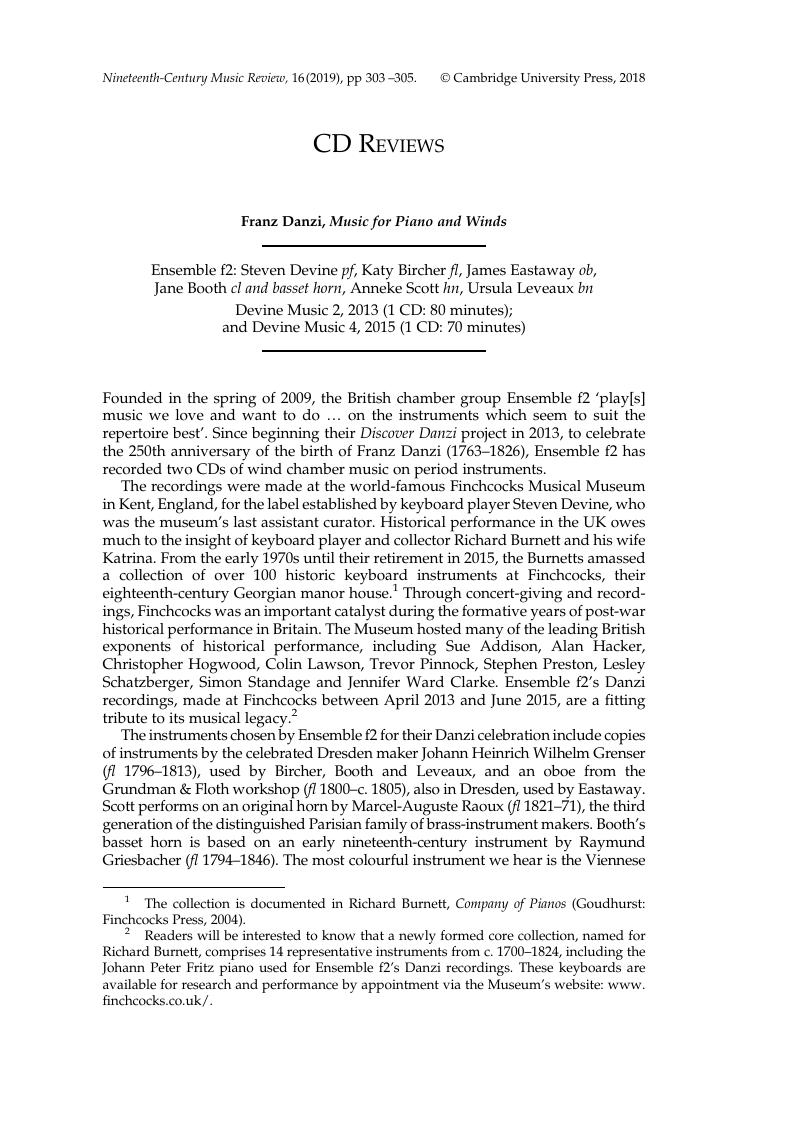No CrossRef data available.
Published online by Cambridge University Press: 11 December 2018

1 The collection is documented in Burnett, Richard, Company of Pianos (Goudhurst: Finchcocks Press, 2004)Google Scholar.
2 Readers will be interested to know that a newly formed core collection, named for Richard Burnett, comprises 14 representative instruments from c. 1700–1824, including the Johann Peter Fritz piano used for Ensemble f2’s Danzi recordings. These keyboards are available for research and performance by appointment via the Museum’s website: www.finchcocks.co.uk/.
3 Burnett, Company of Pianos, 122.
4 During Danzi’s adult life audiences, particularly in Vienna, were familiar with mehter: military ensembles of wind and percussion instruments from the Ottoman Empire. These bands comprised Janissaries or members of the Sultan’s élite troops. Their exotic instruments and distinctive timbres were imitated by late eighteenth- and early nineteenth-century Viennese piano makers, who fitted a pedal to their instruments
5 , M.C.C. [Mrs.Walter, Carr, aka Carr, Mary C.], ‘Danzi, Franz’ in A Dictionary of Music and Musicians, vol. 1 (London: Macmillan and Co., 1879), 430Google Scholar. Little-known today, Carr was described in 1901 as ‘a most valued contributor to Sir George Grove’s Dictionary’, The Musical Times and Singing Class Circular, 42, no. 696 (1 February 1901): 101Google Scholar.
6 ‘des combinations harmoniques dépourvues du charme de la mélodie, ce qui est d’autant plus étonnant qu’il connaissait bien l’art du chant, et qu’il l’enseignait à merveille’: Fétis, François-Joseph, ‘Danzi (François)’, Biographie universelle des musiciens et bibliographie générale de le musique, vol. 2 (Paris: Firmin Didot Frères, 1867), 427Google Scholar.
7 ‘noch immer für das Wesentliche in der Musik halte’: Franz Danzi, letter to Johann Anton André (29 October 1822), reprinted in von Pechstaedt, Volkmar, ed., Franz Danzi: Breifwechsel (1785–1826) (Tutzing: Hans Schneider, 1997), 212–213Google Scholar.
8 Neidich and Levin recorded for Sony SK 64302 (1994), and Lawson and Da Costa can be heard on Clarinet Classics CC0015 (1996).
9 The Early Clarinet Family, Clarinet Classics 4 (1993).
10 Maury and Penson’s recording was rereleased in 2009 by Ricercar Academy on CD, RIC 287.
11 New Classical Adventure 60174-215 (2007).